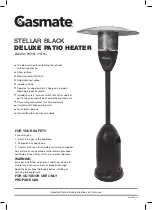
8
Environmental protection/disposal
S 32/5 – 6 720 804 007 (2014/10)
14
7.2
Shutting down the heating system when there is a
risk of frost
▶ Shut down the heating system and the tank as shown in chapter 7.1.
8
Environmental protection/disposal
Environmental protection is one of the fundamental company policies of
the Bosch Group. We regard quality of performance, economy and
environmental protection as equal objectives.
Environmental protection laws and regulations are strictly adhered to.
To protect the environment, we use the best possible technology and
materials taking into account economic points of view.
Packaging
For the packaging, we participate in the country-specific recycling
systems, which guarantee optimal recycling. All packaging materials
used are environmentally-friendly and recyclable.
Old electrical and electronic appliances
Electronic or electrical or electronic equipment hat can no
longer be used must be collected separately and properly
recycled (European Directive on Waste: Electrical and
Electronic Equipment).
Use the return and collection systems specified by federal
law to dispose of electrical and electronic waste.
9
Maintenance
▶ Allow the DHW tank to cool down sufficiently before performing any
maintenance.
▶ Carry out cleaning and maintenance procedures in the specified
intervals.
▶ Remedy all faults immediately.
▶ Use original spare parts only!
▶ The tank must be inspected annually and maintained as required.
9.1
Testing the safety valve
▶ Check the T&P safety valve annually.
9.1.1
Drain the tank
▶ Isolate the tank on the DHW side from the piping by closing the shut-
off valves.
▶ To vent the system, open the highest faucet.
▶ Open drain valve (
Fig. 2 [12], page 6).
9.1.2
Descaling/cleaning the tank
▶ Close the cold water inlet shutoff valve.
▶ Drain the tank via the drain valve by opening the highest faucet.
▶ Check the DHW tank interior for deposits (limescale).
▶ Hose down the inside of the tank.
Fig. 14 Hosing down the inside of the tank
▶ Use a wet & dry vacuum cleaner with plastic suction hose to remove
the residues.
▶ Seal the plug back into the inspection port.
9.1.3
Checking the magnesium anode
The magnesium anode protects the DHW tank from corrosion. Check the
magnesium anode annually to determine whether it needs to be
changed.
The surface of the magnesium anode must be free of deposits. Exchange
the magnesium anode when deposits collect, the surface is enlarged
from deposits, or the diameter is less than 5/8" (15 mm).
Certain installations may require more frequent replacement of the
magnesium anode rod:
• Recirculation connection
• Poor water quality
• corrosion protection
• High flow rate
Fully drain the tank – even the lowest section of the tank
and the heating coil.
In order to improve the cleaning effect, heat up the
indirect coil prior to hosing them down with a water jet.
The thermal shock effect helps to loosen encrustations
(e. g. lime deposits).
NOTICE:
Damage to the enamel finish!
▶ Do not use tools for the removal of deposits from the
interior of the tank as it may damage the enamel
liner.
If the magnesium anode is not serviced properly, the
warranty is void.
Annual service records must be kept in a safe location
and submitted together with the original purchase
receipt in the event of a warranty claim.
6 720 801 773-04.2T
72 Psi (5 bar)
50 °F (10 °C)
Summary of Contents for S32/5
Page 34: ...10 S 32 5 6 720 804 007 2014 10 34 Notes ...
Page 35: ...10 S 32 5 6 720 804 007 2014 10 35 Notes ...
Page 36: ......















































